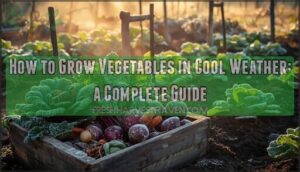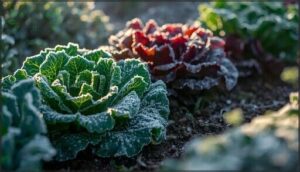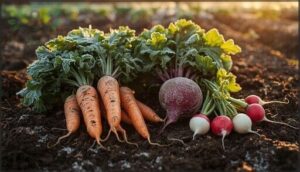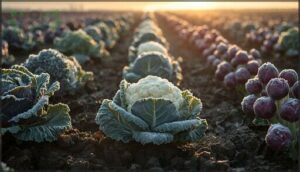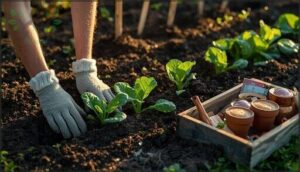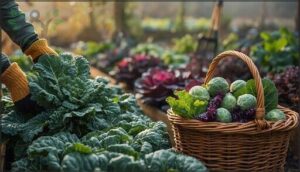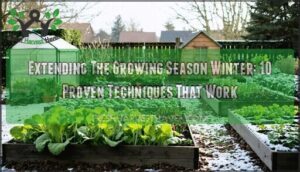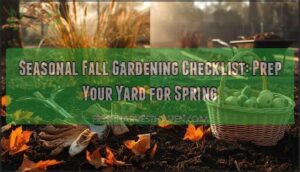This site is supported by our readers. We may earn a commission, at no cost to you, if you purchase through links.
Most gardeners pack up their tools when temperatures drop, but you’re missing out on the most productive season of the year. Cool-weather vegetables don’t just survive frost—they thrive in it. Kale sweetens after a hard freeze, spinach shrugs off 20°F nights, and root vegetables develop flavors you’ll never taste in summer crops.
Research shows these plants accumulate up to 20% more vitamins when they experience mild frost, turning cold stress into nutritional gold. Your spring and fall planting windows open earlier and last longer than they did a decade ago, giving you nearly three extra weeks to work with.
Mastering vegetable gardening in cool weather means harvesting fresh produce when your neighbors’ gardens sit empty, and it starts with understanding which crops excel in the cold and exactly when to put them in the ground.
Table Of Contents
Key Takeaways
- Cool-weather vegetables like kale, spinach, and root crops accumulate up to 20% more vitamins after mild frost exposure, making cold seasons more nutritionally productive than summer harvests.
- Your planting windows have expanded by nearly three weeks compared to a decade ago, giving you two distinct opportunities—early spring (4-6 weeks before last frost) and late summer (8-12 weeks before first hard frost).
- Direct-seed root vegetables like carrots and radishes straight into cool soil between 40-65°F, but transplant brassicas like broccoli and cauliflower for faster harvests and better survival rates.
- Succession planting every 10-14 days for fast growers combined with proper soil preparation (pH 6.0-6.5, rich organic matter) extends your harvest window by several weeks beyond what single plantings deliver.
Best Cool-Weather Vegetables to Grow
Not all vegetables can handle the cold, but the ones that do will reward you with fresh harvests when most gardens sit empty. Your best options fall into a few key categories: hardy greens that laugh at frost, root crops that sweeten as temperatures drop, sturdy brassicas built for cold soil, and speedy growers that beat the season’s clock.
Here’s what you can plant with confidence in cooler weather.
Leafy Greens for Cold Climates
Leafy greens like kale, spinach, and lettuce offer outstanding cold hardiness for your winter harvesting goals. Kale tolerates temperatures down to 5°F and actually tastes sweeter after frost, while spinach withstands 20°F with ease. These cool season crops demonstrate impressive climate resilience and frost tolerance.
You’ll find cold-hardy vegetables thrive when planted in late summer, delivering fresh greens throughout winter months with minimal protection. Understanding cool season greens is key to successful winter harvesting.
Root Vegetables That Thrive in Cool Soil
Root vegetables like carrots, beets, and radishes excel in cool soil temperatures between 40-65°F, delivering sweeter flavors and enhanced nutrients. Soil temperature management is vital—cool-season vegetables accumulate up to 20% more vitamins when exposed to mild frost.
Root vegetables like carrots, beets, and radishes grow sweeter in cool soil and accumulate up to 20% more vitamins after mild frost
You’ll achieve ideal root crop diversity by direct seeding turnips and radishes three weeks before your last frost date.
Master harvest timing strategies for continuous yields throughout fall. Understanding the role of root vegetable types is essential for a successful harvest.
Brassicas and Cole Crops
Broccoli, cauliflower, kale, Brussels sprouts, and cabbage thrive in temperatures between 60-65°F, showcasing remarkable frost tolerance and cold weather adaptation. You’ll find brassica varieties differ in hardiness—Brussels sprouts and kale survive sub-freezing nights better than cauliflower.
Brassica nutrition includes valuable glucosinolates and flavonoids, though cole crop diseases like clubroot and downy mildew require vigilant management through proper drainage and crop rotation.
Quick-Growing Cold-Season Options
When time matters, radishes and arugula deliver fast results—radishes reach harvest in 20 to 30 days, while arugula produces baby leaves within 35 days. These frost-tolerant plants and other cool-season crops thrive as cold-hardy vegetables, making them ideal for cool-weather gardening success.
Quick-maturing cold-hardy greens and fast-growing roots:
- Mustard greens mature in 20 days
- Turnips produce edible roots and greens in 30 to 60 days
- Baby spinach reaches harvest size in 25 to 45 days
- Bok choy grows ready for stir-fry in 30 to 50 days
- Bush beans yield continuous pods starting at 50 days
When to Plant Your Cool-Weather Garden
Timing is everything for cool-weather gardening. You’ve got two main planting windows to work with, and knowing how they align with your local frost dates makes all the difference.
Let’s break down when to get your seeds and transplants in the ground for the best results.
Early Spring Planting Windows
You can start your spring garden earlier than you might think. Most frost-tolerant vegetables can be directly sown outdoors from April 10 to April 25, once soil temperature reaches 40–50°F. Seed starting for cool-season crops like peas, spinach, and radishes works well 4–6 weeks before your last frost date.
Climate trend analysis shows spring planting windows now open nearly three weeks earlier than previous decades, giving you more flexibility for cool weather crops and spring garden prep.
Late Summer and Fall Planting
For gardeners committed to season extension, late summer planting opens a second harvest window. You’ll want to transplant broccoli, cabbage, and cauliflower seedlings 10–12 weeks before your first hard frost—usually mid-July through early September in temperate zones. Direct-seed carrots, beets, and leafy greens 8–10 weeks out.
Cool-season gardening rewards early preparation with winter harvesting success and reliable frost protection strategies.
Understanding Frost Dates and Timing
Your region’s frost dates anchor every cool-season planting decision. The last spring frost—when nighttime temperatures drop below 32°F for the final time—determines when you can safely direct-seed peas, spinach, and lettuce.
Most USDA zones carry a two-week variability window, so factor in frost tolerance levels and local climate trends when scheduling cool-weather crops for best freeze protection.
Preparing Soil and Choosing Garden Locations
Your garden’s success starts beneath the surface, where soil quality and sunlight directly determine how well your cool-weather crops perform. Getting these fundamentals right means the difference between a thriving harvest and a disappointing one.
Let’s look at what your plants need before they go in the ground.
Soil Requirements for Cool-Season Crops
Your cool-season crops won’t thrive unless soil conditions align with their needs. Most vegetables prefer a pH between 6.0 and 6.5, supporting nutrient cycling and root development.
Boost organic matter through compost or cover crops to improve water retention and soil temperature stability.
Proper soil preparation with well-drained, fertile ground sets the foundation for successful cool-season gardening and productive harvests.
Sun and Shade Considerations
Most cool-season vegetables need at least 6 hours of direct sunlight daily, though leafy greens like spinach and kale tolerate partial sun with just 4–6 hours. Garden orientation matters—morning sun exposure with afternoon shade reduces frost damage and heat stress.
Shade management through selective pruning increases light penetration, while root crops in partial sun show reduced size. Full sun maximizes yields, especially for fruiting vegetables like peas.
Improving Soil With Organic Matter
Think of organic matter as your soil’s life support system. Adding compost or aged manure boosts microbial activity by nearly 50%, improving nutrient cycling and water retention. You’ll increase soil carbon by 17% and nitrogen by 22%, building fertility that feeds your plants steadily.
Organic fertilizers support soil microbes while enhancing carbon sequestration. Mulching after fertilizing locks in moisture and continues enriching your garden’s foundation.
Planting Techniques for Cool-Weather Success
Getting your seeds in the ground the right way makes all the difference between a thriving garden and a frustrating one. The technique you choose—and how carefully you execute it—directly affects germination rates and early plant health.
Let’s walk through the core planting methods that set cool-weather crops up for success.
Direct Seeding Vs. Transplanting
Your establishment method shapes both crop yields and gardening costs for cool-season gardening. Transplanting seedlings speeds up harvests and cuts transplant shock risk, while direct sowing reduces expenses and suits many vegetables perfectly. Here’s what works best:
- Direct sow carrots, beets, radishes, peas, and spinach—root crops need undisturbed soil for proper development and seed germination
- Transplant broccoli, lettuce, onions, and peppers for earlier harvests and higher survival rates in cool conditions
- Consider both methods for arugula and kale, depending on your soil preparation timeline and season length
Proper Seed Depth and Spacing
After seed starting and transplanting, soil preparation and planting depth make or break your cool-season gardening success. Plant lettuce, spinach, and carrot seeds at 0.25 inch deep for germination rates above 85%.
Space leafy greens 2–4 inches apart and root vegetables 1–2 inches for straight development. Brassicas need 18–24 inches between plants to optimize crop yield—tight spacing reduces harvests by 14% and increases disease pressure.
Protecting Seeds During Germination
After planting at the right depth and spacing, shield your seeds from cold stress and disease. Fabric row covers boost soil temperature by 5–10°F and lift germination rates above 85% for cool-season gardening.
Seed coatings with fungicides cut damping-off by 29–38%, while proper drainage prevents seed rot. These frost protection methods turn cold-hardy vegetables into reliable performers during seed starting.
Maintaining and Harvesting Your Cool-Season Garden
Once your cool-season crops are in the ground, they don’t need constant attention, but a little regular care makes all the difference between a decent harvest and a truly productive garden.
You’ll want to stay on top of watering schedules, keep an eye out for pests, and know exactly when each vegetable hits its peak.
Here’s what you need to focus on to keep your garden thriving and your harvest basket full.
Watering and Fertilizing Requirements
Your cool-weather crops need about 1 inch of water per week to keep soil moisture steady. Drip irrigation systems work best—they deliver nutrients straight to roots while conserving water. Sandy soils drain fast, so water twice weekly instead of once.
For fertilizer types, nitrogen is key: apply 60–300 lb/acre depending on your crop, timing applications to match growth stages for smart nutrient management.
Managing Weeds and Pests
Before anything else, tackle weeds with proven organic methods: preirrigation cycles cut weed pressure by half, while thick mulch reduces hand-weeding labor up to 60%.
For pest control, implement 3-4 year crop rotation to disrupt life cycles and boost soil health.
Companion planting and mechanical cultivation keep your garden thriving without chemicals—smart gardening techniques that deliver real weed suppression results.
Knowing When to Harvest Each Vegetable
Timing matters more than you think—broccoli heads harvested when buds stay tightly closed yield the best flavor, while carrots reach peak sweetness at 1/2 to 3/4 inch diameter. Harvest signs like firm Brussels sprouts at 1 inch or tender kale leaves guide your vegetable yield.
Frost tolerance actually improves root crop quality, making harvesting fall vegetables rewarding when you know crop maturity indicators.
Extending Your Harvest With Succession Planting
Your harvest window stretches weeks longer when you stagger sowings every 10 to 14 days. Succession planting works like clockwork in cool-season gardening, delivering continuous yields instead of feast-or-famine crops.
Extending the growing season through vegetable crop rotation and smart planning keeps your table full all season.
Here are some key strategies:
- Plant fast growers like radishes and arugula at 7-day intervals for steady supply
- Schedule leafy greens every two weeks through spring and fall
- Rotate crop families across beds for soil management and pest control
- Use row covers for season extension when frost threatens
- Adjust harvest scheduling based on your succession sowing timeline
Frequently Asked Questions (FAQs)
How do I protect plants from unexpected freezes?
When frost threatens, cover your crops with blankets or frost cloths—they’ll boost temperatures by 4 to 10°F around plants. Water beforehand too, since moist soil holds heat better than dry.
Can I grow vegetables in containers during winter?
Yes, you can grow cool-season crops like kale, spinach, and carrots in containers during winter. Choose containers at least 2 gallons, use well-drained soil, and protect with row covers during freezes.
What are common cool-weather gardening mistakes to avoid?
Don’t skip frost protection or plant too early—those missteps alone claim over 60% of cold-season crops. Poor drainage, wrong varieties, and erratic watering also undermine cool-season gardening success markedly.
How does mulching affect cool-season vegetable growth?
Mulching benefits cool-season vegetables by regulating soil temperature, conserving water, and suppressing weeds.
Organic mulches can raise temperatures by 2–3°C, while increasing moisture retention and reducing labor, ultimately boosting crop yields.
Which vegetables can handle the earliest spring planting?
When your soil first thaws, it’s like nature opening the starting gate—peas, spinach, and kale lead the pack as frost-tolerant, cold-hardy vegetables perfect for early spring planting in cool-season gardens.
Conclusion
When the thermometer takes a dive, your garden doesn’t have to sleep. Vegetable gardening in cool weather lets you harvest kale, carrots, and spinach while others wait for spring.
You’ve learned which crops handle frost, when to plant them, and how to prepare your soil for success. Now it’s time to put seeds in the ground and watch cool-season varieties outperform anything your summer garden produced.
Your year-round harvest starts today.
- https://cropcareequipment.com/blog/crops-to-grow-in-winter/
- https://lettucegrowsomething.com/when-to-plant-cool-season-vegetables-in-the-garden/
- https://extension.umd.edu/resource/low-yields-or-undersized-vegetables
- https://www.sustainablemarketfarming.com/2021/04/14/winter-kill-temperatures-of-cold-hardy-vegetables-2021/
- https://squarefootgardening.org/2024/08/grow-cool-season-vegetables-garden/

